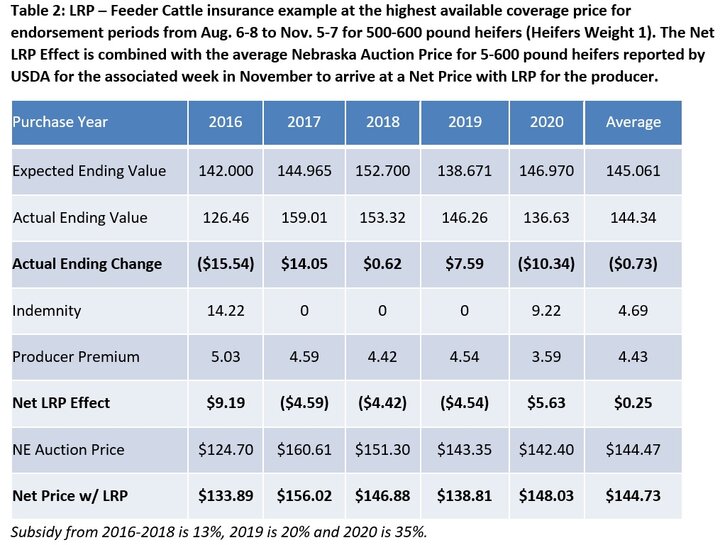In an effort to improve participation, several enhancements and improvements to the Livestock Risk Protection (LRP) insurance program for cattle have taken place over the last three years.
They include:
- Increasing subsidy levels for all coverage prices (see Table 1).
- Changing the premium due date to the end of the coverage period rather than the beginning.
- Increasing the number of head of cattle that can be insured per endorsement and per year from 1,000 head and 2,000 head, respectfully, to 6,000 head and 12,000 head, respectfully.
- Expanding the window before the end of the endorsement period to make cash sales without affecting coverage from 30 days to 60 days.
- Creating a new unborn feeder cattle type to allow for unborn calves to be insured.
- Updating Chicago Mercantile Exchange (CME) trading requirements to allow for more insurance coverage levels and endorsement lengths to be offered to producers.
Premium subsidy levels have increased dramatically over the past two years. Since its inception in 2003, LRP cattle policy premiums had been subsidized at 13%. These subsidy rates increased to 20-35% in 2018, to 25-45% in mid-2020, and finally to a range from 35-55% in September 2020 effective retroactively to July 1, 2020. In addition, new and beginning producers can qualify for an additional 10% premium subsidy.
Table 1: Livestock Risk Protection (LRP) insurance premium subsidies for cattle policies
|
Coverage Price |
Subsidy |
|
95-100% |
35% |
|
90-94.99% |
40% |
|
85-89.99% |
45% |
|
80-84.99% |
50% |
|
75-79.99% |
55% |
|
70-74.99% |
55% |
New and beginning producers qualify for an additional 10% subsidy.
LRP-Feeder Cattle Coverage Data Example
The shortest coverage period for LRP insurance coverage for feeder cattle is 13 weeks, or approximately 3 months. A 13-week LRP insurance endorsement entered in early August would have an ending date in early November. Table 2 contains five years of data for LRP insurance coverage on heifers weighing less than 600 pounds (Heifers Weight 1) with a coverage endorsement period starting August 6 (or soon thereafter) and ending between November 5 and 7. The expected ending value for Heifers Weight 1 on those ending dates from 2016-20 averaged $145.061 per cwt. The actual ending value averaged $144.34 per cwt.
However, LRP insurance coverage is not about insuring averages but rather about insuring against downward turns in the market. Note the downward turn in the market over these three months in 2016 and 2020 of $15.54 and $10.34 per cwt., respectively. Insured at the highest coverage level each year, LRP coverage would have returned indemnities of $14.22 and $9.22 per cwt., respectively, for each of these years. Using the premium rates in effect at the time, producer premiums of $5.03 and $3.59, respectively, would have been subtracted from these indemnities to produce a net positive effect from the LRP insurance of $9.19 and $5.63 per cwt., respectively.

LRP insurance is an important tool in the toolbox for livestock producers to use in managing national market price risk. The producer still markets the cattle to the best of their ability in the local market. For example, the average Nebraska Auction market prices for 5-600 pound heifers for the corresponding week in November was added to the data in Table 2. In 2016 and 2020, the positive LRP insurance effect would have added to the local auction market price to increase net returns to the producer. From 2017-2019, LRP insurance premium costs would have reduced net returns to the producer. Overall, the LRP effect averaged a positive $0.25 return to the producer over the five year period. However, it closes up the range of outcomes by adding to the auction prices received in the down years in exchange for subtracting premium costs from those prices received in the better years.
For more information on LRP insurance visit https://www.rma.usda.gov/Policy-and-Procedure/Insurance-Plans/Livestock-Insurance-Plans or contact your local livestock insurance agent.
This material is based upon work supported by USDA/NIFA under Award Number 2018-70027-28586.
Interviews with the authors of BeefWatch newsletter articles become available throughout the month of publication and are accessible at https://go.unl.edu/podcast.
Topics covered:
Marketing & risk management, Marketing, budgets & management

